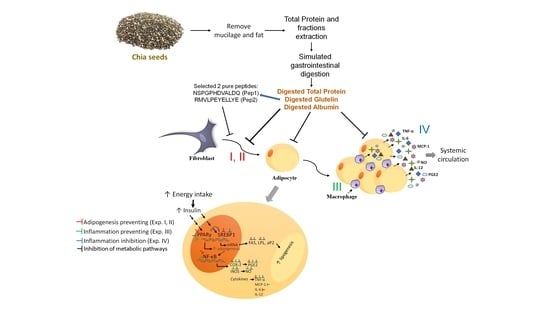Protein Digests and Pure Peptides from Chia Seed Prevented Adipogenesis and Inflammation by Inhibiting PPARγ and NF-κB Pathways in 3T3L-1 Adipocytes
Abstract
1. Introduction
2. Materials and Methods
2.1. Materials
2.2. Preparation of Digested Total Protein and Protein Fractions
2.3. Identification, Characterization of Potentially Bioactive Peptides
2.4. Cell Culture
2.5. Experimental Design and Treatment of Cells with Digested Total Protein, Digested Albumin, Glutelin or Pure Peptides
2.5.1. Experiment I: Effects of DTP or Digested Albumin or Glutelin in 3T3-L1 Adipocytes during the Differentiation Process.
2.5.2. Experiment II: Effects of Pure Peptides in 3T3-L1 Adipocytes during the Differentiation Process: 3T3-L1 Cells Were Seeded and Differentiated as Described above
2.5.3. Experiment III: Effects of DTP or Digested Albumin or Glutelin before (Prevention) Induced Inflammation in Mature Adipocytes by Addition of Conditioned Media from Inflamed Macrophages
2.5.4. Experiment IV: Effects of DTP or Digested Albumin or Glutelin after (Inhibition) Induced Inflammation in Mature Adipocytes by Addition of Conditioned Media from Inflamed Macrophages (CM)
2.6. Effect of Either Digested Total Protein, Digested Albumin or Digested Glutelin or Pure Peptides in Nitric Oxide and Reactive Oxygen Species Production
2.7. Effect of Either Digested Total Protein or Digested Albumin, Glutelin or Pure Peptides on Cellular Lipid Accumulation
2.8. Impact of Either Digested Total Protein or Digested Albumin, Glutelin or Pure Peptides in PGE2, TNF-α, MCP-1 and Cytokines Secretion
2.9. Influence of Either Digested Total Protein or Digested Albumin, Glutelin or Pure Peptides in the Expression of Proteins Related to Adipogenesis and Inflammation Processes
2.10. Effects of Either Digested Total Protein or Digested Albumin, Glutelin or Pure Peptides on Inhibition of Lipase Activity and Triglyceride Content
2.11. Potential Inhibitory Interactions of PPARγ, FAS and MAGL by Peptides from Digested Total Protein, Digested Albumin or Glutelin: In Silico Analyses
2.12. Statistical Analysis
3. Results
3.1. Effect of Digested Total Protein (DTP), Digested Albumin and Glutelin and Pure Peptides on Adipogenesis Development in the Adipocytes Cells
3.1.1. The Digested Total Protein (DTP), Digested Albumin and Glutelin and Pure Peptide Pep2 Reduced the Differentiation of Adipocytes and Oxidative Stress in the Adipogenesis Development
3.1.2. The Digested Total Protein (DTP), Digested Albumin and Glutelin and Pure Peptides, Pep1 and Pep2, Reduced the Lipid Accumulation in the Adipogenesis Development
3.1.3. The Digested Albumin and Glutelin and Pure Peptides, Pep1 and Pep2, Reduced the Inflammatory Markers in the Adipogenesis Development
3.2. Effect of DTP and Digested Albumin and Glutelin on Inflammation in Mature Adipocytes
3.2.1. DTP and Digested Albumin and Glutelin Fractions Reduced the Oxidative Stress in the Prevention and Inhibition of Induced Inflammation in Mature Adipocytes
3.2.2. DTP and Digested Albumin and Glutelin Fractions Reduced Lipid Accumulation in the Prevention and Inhibition of Induced Inflammation in Mature Adipocytes
3.2.3. DTP and Digested Albumin and Glutelin Reduced Inflammatory Markers in Prevention and Inhibition of Induced Inflammation
3.3. In Silico Interaction of Peptides from Digested Albumin and Glutelin and Pure Peptides with PPARγ, FAS and MAGL
4. Discussion
5. Conclusions
Supplementary Materials
Author Contributions
Funding
Institutional Review Board Statement
Informed Consent Statement
Data Availability Statement
Acknowledgments
Conflicts of Interest
References
- Sacks, F.M.; Lichtenstein, A.H.; Wu, J.H.; Appel, L.J.; Creager, M.A.; Kris-Etherton, P.M.; Miller, M.; Rimm, E.B.; Rudel, L.L.; Robinson, J.G.; et al. Dietary fats and cardiovascular disease: A presidential advisory from the American Heart Association. Circulation 2017, 136, e1–e23. [Google Scholar] [CrossRef] [PubMed]
- Eckel, R.H.; Krauss, R.M. American Heart Association Call to Action: Obesity as a Major Risk Factor for Coronary Heart Disease. Cardiovasc. News 1998, 97, 2099–2100. [Google Scholar] [CrossRef] [PubMed]
- WHO. Obesity and Overweight. 2018. Available online: https://www.who.int/en/news-room/fact-sheets/detai; https://www.who.int/en/news-room/fact-sheets/detail/obesity-and-overweight (accessed on 22 January 2019).
- Rosen, E.D.; Macdougald, O.A. Adipocyte differentiation from the inside out. Nat. Rev. 2006, 7, 885–896. [Google Scholar] [CrossRef] [PubMed]
- Koliaki, C.; Liatis, S.; Kokkinos, A. Obesity and cardiovascular disease: Revisiting an old relationship. Metab. Clin. Exp. 2018, 92, 98–107. [Google Scholar] [CrossRef]
- Chylikova, J.; Dvorackova, J.; Tauber, Z.; Kamarad, V. M1/M2 macrophage polarization in human obese adipose tissue. Biomed. Pap. Med. Fac. Univ. Palacky Olomouc. 2018, 162, 79–82. [Google Scholar] [CrossRef]
- Weisberg, S.P.; Mccann, D.; Desai, M.; Rosenbaum, M.; Leibel, R.L.; Ferrante, A.W. Obesity is associated with macrophage accumulation. J. Clin Investig. 2003, 112, 1796–1808. [Google Scholar] [CrossRef]
- Heilbronn, L.K.; Campbell, L.V. Adipose Tissue Macrophages, Low Grade Inflammation and Insulin Resistance in Human Obesity. Curr. Pharm. Des. 2008, 14, 1225–1230. [Google Scholar] [CrossRef]
- Swinburn, B.A.; Sacks, G.; Hall, K.D.; Mcpherson, K.; Finegood, D.T.; Moodie, M.L.; Gortmaker, S.L. The global obesity pandemic: Shaped by global drivers and local environments. Lancet 2011, 378, 804–814. [Google Scholar] [CrossRef]
- Springer, M.; Moco, S. Resveratrol and Its Human Metabolites—Effects on Metabolic Health and Obesity. Nutrients 2019, 11, 143. [Google Scholar] [CrossRef]
- Keller, U. Dietary proteins in obesity and in diabetes. Int. J. Vitam. Nutr. Res. 2011, 81, 125–133. [Google Scholar] [CrossRef]
- Ixtaina, V.Y.; Nolasco, S.M.; Tomas, M.C. Physical properties of chia (Salvia hispanica L.) seeds. Ind. Crop. Prod. 2008, 28, 286–293. [Google Scholar] [CrossRef]
- Nieman, D.C.; Gillitt, N.; Jin, F.; Henson, D.A.; Kennerly, K.; Shanely, R.A.; Ore, B.; Su, M.; Schwartz, S. Chia Seed Supplementation and Disease Risk Factors in Overweight Women: A Metabolomics Investigation. J. Altern. Complement. Med. 2012, 18, 700–708. [Google Scholar] [CrossRef] [PubMed]
- Nieman, D.C.; Cayea, E.J.; Austin, M.D.; Henson, D.A.; McAnulty, S.R.; Jin, F. Chia seed does not promote weight loss or alter disease risk factors in overweight adults. Nutr. Res. 2009, 29, 414–418. [Google Scholar] [CrossRef] [PubMed]
- Jin, F.; Nieman, D.C.; Sha, W.; Xie, G.; Qiu, Y.; Jia, W. Supplementation of Milled Chia Seeds Increases Plasma ALA and EPA in Postmenopausal Women. Plant. Foods Hum. Nutr. 2012, 67, 105–110. [Google Scholar] [CrossRef]
- Poudyal, H.; Panchal, S.K.; Ward, L.C.; Brown, L. Effects of ALA, EPA and DHA in high-carbohydrate, high-fat diet-induced metabolic syndrome in rats. J. Nutr. Biochem. 2013, 24, 1041–1052. [Google Scholar] [CrossRef]
- Toscano, L.T.; da Silva, C.S.O.; Toscano, L.T.; de Almeida, A.E.M.; da Cruz, S.A.; Silva, A.S. Chia flour supplementation reduces blood pressure in hypertensive subjects. Plant Food Hum. Nutr. 2014, 69, 392–398. [Google Scholar] [CrossRef]
- Vuksan, V.; Choleva, L.; Jovanovski, E.; Jenkins, A.L.; Au-Yeung, F.; Dias, A.G.; Ho, H.V.T.; Zurbau, A.; Duvnjak, L. Comparison of flax (Linum usitatissimum) and Salba-chia (Salvia hispanica L.) seeds on postprandial glycemia and satiety in healthy individuals: A randomized, controlled, crossover study. Eur. J. Clin. Nutr. 2017, 71, 234–238. [Google Scholar] [CrossRef]
- Grancieri, M.; Martino, H.S.D.; De Mejia, E.G. Digested total protein and protein fractions from chia seed (Salvia hispanica L.) had high scavenging capacity and inhibited 5-LOX, COX-1-2, and iNOS enzymes. Food Chem. 2019, 289, 204–214. [Google Scholar] [CrossRef]
- 20. Kačmárová K, Lavová B, Socha P, Urminská, D. Characterization of protein fractions and antioxidant activity of chia seeds (Salvia hispanica L.). Potravinarstvo 2016, 10, 78–82.
- Orona-Tamayo, D.; Valverde, M.E.; Nieto-Rendón, B.; Paredes-López, O. Inhibitory activity of chia (Salvia hispanica L.) protein fractions against angiotensin I-converting enzyme and antioxidant capacity. LWT Food Sci. Technol. 2015, 64, 236–242. [Google Scholar]
- Cicero, A.F.G.; Fogacci, F.; Colletti, A. Potential role of bioactive peptides in prevention and treatment of chronic diseases: A narrative review. Br. J. Pharmacol. 2017, 174, 1378–1394. [Google Scholar] [CrossRef] [PubMed]
- Segura, C.M.R.; Peralta, G.F.; Chel, G.L.; Betancur, A.D. Angiotensin I-converting enzyme inhibitory peptides of chia (Salvia hispanica) produced by enzymatic hydrolysis. Int. J. Food Sci. 2013, 2013, 1–8. [Google Scholar] [CrossRef]
- Coelho, M.S.; Soares-Freitas, R.A.M.; Areas, J.A.G.; Gandra, E.A.; Salas-Mellado, M.; de las, M. Peptides from Chia present antibacterial activity and anhibit cholesterol synthesis. Plant. Foods Hum. Nutr. 2018, 73, 101–107. [Google Scholar] [CrossRef] [PubMed]
- Grancieri, M.; Martino, H.S.D.; de Mejia, E.G. Chia (Salvia hispanica L.) Seed Total Protein and Protein Fractions Digests Reduce Biomarkers of Inflammation and Atherosclerosis in Macrophages in vitro. Mol. Nutr. Food Res. 2019, 63, 1900021. [Google Scholar] [CrossRef]
- Osbore, T. The Vegetable Proteins; Longmans, Green and Co.: London, UK, 1924. [Google Scholar]
- Megías, C.; Del, M.Y.M.; Pedroche, J.; Lquari, H.; Girón-Calle, J.; Alaiz, M.; Millán, F.; Vioque, J. Purification of an ACE Inhibitory Peptide after Hydrolysis of Sunflower (Helianthus annuus L.) Protein Isolates. J. Agric. Food Chem. 2004, 52, 1928–1932. [Google Scholar]
- Mojica, L.; Chen, K.; de Mejía, E.G. Impact of Commercial Precooking of Common Bean (Phaseolus vulgaris) on the Generation of Peptides, After Pepsin-Pancreatin Hydrolysis, Capable to Inhibit Dipeptidyl Peptidase-IV. J. Food Sci. 2015, 80, H188–H198. [Google Scholar] [CrossRef]
- Zebisch, K.; Voigt, V.; Wabitsch, M.; Brandsch, M. Protocol for effective differentiation of 3T3-L1 cells to adipocytes. Anal. Biochem. 2012, 425, 88–90. [Google Scholar] [CrossRef] [PubMed]
- Green, L.C.; Wagner, D.A.; Glogowski, J.; Skipper, P.L.; Wishnok, J.S.; Tannenbaum, S.R. Analysis of Nitrate, Nitrite, and [15N] Nitrate in Biological Fluids. Anal. Biochem. 1982, 126, 131–138. [Google Scholar] [CrossRef]
- Luna-Vital, D.; Weiss, M.; de Mejia, E.G. Anthocyanins from purple corn ameliorated tumor necrosis factor-α-induced inflammation and insulin resistance in 3T3-L1 adipocytes via activation of insulin signaling and enhanced GLUT4 translocation. Mol. Nutr. Food Res. 2017, 61, 1–13. [Google Scholar] [CrossRef]
- Trott, O.; Olson, A. AutoDock Vina: Improving the speed and accuracy of docking with a new scoring function, efficient optimization and multithreading. J. Comput. Chem. 2010, 31, 455–461. [Google Scholar] [CrossRef] [PubMed]
- Wu, H.; Ni, X.; Xu, Q.; Wang, Q.; Li, X.; Hua, J. Regulation of lipid-induced macrophage polarization through modulating PPAR-γ activity affects hepatic lipid metabolism via TLR4/NF-κB signaling pathway. J. Gastroenterol. Hepatol. 2020, 81770572. [Google Scholar] [CrossRef] [PubMed]
- Pemble, C.W.; Johnson, L.C.; Kridel, S.J.; Lowther, W.T. Crystal structure of the thioesterase domain of human fatty acid synthase inhibited by Orlistat. Struct. Mol. Biol. 2007, 14, 704–709. [Google Scholar]
- Wang, J.; Zhang, X.; Yang, C.; Zhao, S. Effect of monoacylglycerol lipase inhibition on intestinal permeability in chronic stress model. Biochem. Biophys. Res. Commun. 2020, 525, 962–967. [Google Scholar] [CrossRef]
- Grancieri, M.; Martino, H.S.D.; Gonzalez de Mejia, E. Chia Seed (Salvia hispanica L.) as a Source of Proteins and Bioactive Peptides with Health Benefits: A Review. Compr. Rev. Food Sci. Food Safe 2019, 18, 480–499. [Google Scholar] [CrossRef] [PubMed]
- Kamble, P.G.; Hetty, S.; Vranic, M.; Almby, K.; Castillejo-López, C.; Abalo, X.M.; Eriksson, J.W. Proof-of-concept for CRISPR/Cas9 gene editing in human preadipocytes: Deletion of FKBP5 and PPARG and effects on adipocyte differentiation and metabolism. Sci. Rep. 2020, 10, 1–14. [Google Scholar] [CrossRef]
- Miard, S.; Fajas, L. Atypical transcriptional regulators and cofactors of PPARγ. Int. J. Obes. 2005, 29, S10–S12. [Google Scholar] [CrossRef]
- Martino, H.S.D.; Dias, M.M.S.; Noratto, G.; Talcott, S.; Mertens-Talcott, S.U. Anti-lipidaemic and anti-inflammatory effect of açai (Euterpe oleracea Martius) polyphenols on 3T3-L1 adipocytes. J. Funct. Foods 2016, 23, 432–443. [Google Scholar]
- Li, Y.; He, P.P.; Zhang, D.W.; Zheng, X.L.; Cayabyab, F.S.; Yin, W.D.; Tang, C.K. Lipoprotein lipase: From gene to atherosclerosis. Atherosclerosis 2014, 237, 597–608. [Google Scholar]
- Tengku-muhammad, T.S.; Cryer, A.; Ramji, D.P. Synergism between interferon g and tumour necrosis factor a in the regulation of lipoprotein lipase in the macrophage j774.2 cell line. Cytokine 1998, 10, 38–48. [Google Scholar] [CrossRef]
- Vuksan, V.; Jenkins, A.L.; Brissette, C.; Choleva, L.; Jovanovski, E.; Gibbs, A.L.; Bazinet, R.P.; Au-Yeung, F.; Zurbau, A.; Ho, H.V.T.; et al. Salba-chia (Salvia hispanica L.) in the treatment of overweight and obese patients with type 2 diabetes: A double-blind randomized controlled trial. Nutr. Metab. Cardiovasc. Dis. 2017, 27, 138–146. [Google Scholar]
- Toscano, L.T.; Toscano, L.T.; Tavares, R.L.; da Oliveira Silva, C.S.; Silva, A.S. Chia induces clinically discrete weight loss and improves lipid profile only in altered previous values. Nutr. Hosp. 2014, 31, 1176–1182. [Google Scholar]
- Poudyal, H.; Panchal, S.K.; Ward, L.C.; Waanders, J.; Brown, L. Chronic high-carbohydrate, high-fat feeding in rats induces reversible metabolic, cardiovascular, and liver changes. Am. J. Physiol. Endocrinol. Metab. 2012, 302, E1472–E1482. [Google Scholar] [CrossRef] [PubMed]
- Jensen-Urstad, A.P.L.; Semenkovich, C.F. Fatty acid synthase and liver triglyceride metabolism: Housekeeper or messenger? Biochim. Biophys. Acta. 2012, 1821, 747–753. [Google Scholar] [CrossRef] [PubMed]
- Angeles, T.S.; Hudkins, R.L. Recent advances in targeting the fatty acid biosynthetic pathway using fatty acid synthase inhibitors. Expert. Opin. Drug Discov. 2016, 11, 1187–1199. [Google Scholar] [PubMed]
- Liu, L.-H.; Wang, X.-K.; Hu, Y.-D.; Kang, J.-L.; Wang, L.-L.; Li, S. Effects of a fatty acid synthase inhibitor on adipocyte differentiation of mouse 3T3-L1 cells. Acta Pharmacol. Sin. 2004, 25, 1052–1057. [Google Scholar]
- Rossi, A.S.; Oliva, M.E.; Ferreira, M.R.; Chicco, A.; Lombardo, Y.B. Dietary chia seed induced changes in hepatic transcription factors and their target lipogenic and oxidative enzyme activities in dyslipidaemic insulin-resistant rats. Br. J. Nutr. 2013, 109, 1617–1627. [Google Scholar]
- DeBoer, M.D. Obesity, systemic inflammation, and increased risk for cardiovascular disease and diabetes among adolescents: A need for screening tools to target interventions. Nutrition 2013, 29, 379–386. [Google Scholar]
- Ghigliotti, G.; Barisione, C.; Garibaldi, S.; Fabbi, P.; Brunelli, C.; Spallarossa, P.; Altieri, P.; Rosa, G.; Spinella, G.; Palombo, D.; et al. Adipose Tissue Immune Response: Novel Triggers and Consequences for Chronic Inflammatory Conditions. Inflammation 2014, 37, 1337–1353. [Google Scholar]
- Gadina, M.; Gazaniga, N.; Vian, L.; Furumoto, Y. Small Molecules to the Rescue: Inhibition of Cytokine Signaling in Immune-mediated Diseases. J. Autoimmun. 2017, 85, 20–31. [Google Scholar]
- Da Silva, B.P.; Toledo, R.C.L.; Grancieri, M.; Moreira, M.E.C.; Medina, N.R.; Silva, R.R.; Costa, N.M.B.; Martino, H.S.D. Effects of chia (Salvia hispanica L.) on calcium bioavailability and inflammation in Wistar rats. Food Res. Int. 2018, 116, 592–599. [Google Scholar] [CrossRef]
- Park, J.Y.; Chung, T.W.; Jeong, Y.J.; Kwak, C.H.; Ha, S.H.; Kwon, K.M.; Abekura, F.; Cho, S.H.; Lee, Y.C.; Ha, K.T.; et al. Ascofuranone inhibits lipopolysaccharideinduced inflammatory response via nfkappab and ap-1, p-ERK, TNF-α, IL-6 and IL-1β in RAW 264.7 macrophages. PLoS ONE 2017, 12, 1–14. [Google Scholar]
- Xiao, L.; Dong, J.H.; Jin, S.; Xue, H.M.; Guo, Q.; Teng, X.; Wu, Y.M. Hydrogen Sulfide Improves Endothelial Dysfunction via Downregulating BMP4/COX-2 Pathway in Rats with Hypertension. Oxid. Med. Cell Longev. 2016, 2016, 1–10. [Google Scholar] [CrossRef] [PubMed]
- Lee, J.H.; Jung, N.H.; Lee, B.H.; Kim, S.H.; Jun, J.H. Suppression of heme oxygenase-1 by prostaglandin E2-protein kinase A-A-kinase anchoring protein signaling is central for augmented cyclooxygenase-2 expression in lipopolysaccharide-stimulated RAW 264.7 macrophages. Allergy Asthma Immunol. Res. 2013, 5, 329–336. [Google Scholar] [CrossRef] [PubMed]
- Conforti, F.; Menichini, F. Phenolic compounds from plants as nitric oxide production inhibitors. Curr. Med. Chem. 2011, 18, 1137–1145. [Google Scholar]
- Engeli, S.; Janke, J.; Gorzelniak, K.; Böhnke, J.; Ghose, N.; Lindschau, C.; Luft, F.C.; Sharma, A.M. Regulation of the nitric oxide system in human adipose tissue. J. Lipid Res. 2004, 45, 1640–1648. [Google Scholar]
- Han, C.Y. Roles of reactive oxygen species on insulin resistance in adipose tissue. Diabetes Metab. J. 2016, 40, 272–279. [Google Scholar] [CrossRef]
- Maslov, L.N.; Naryzhnaya, N.V.; Boshchenko, A.A.; Popov, S.V.; Ivanov, V.V.; Oeltgen, P.R. Is oxidative stress of adipocytes a cause or a consequence of the metabolic syndrome? J. Clin. Transl. Endocrinol. 2019, 15, 1–5. [Google Scholar] [CrossRef]
- Marineli, R.S.; Lenquiste, S.A.; Moraes, É.A.; Maróstica, M.R. Antioxidant potential of dietary chia seed and oil (Salvia hispanica L.) in diet-induced obese rats. Food Res. Int. 2015, 76, 666–674. [Google Scholar]
- de Souza, F.C.; de Sousa Fomes, L.F.; da Silva, G.E.S.; Rosa, G. Effect of Chia Seed (Salvia Hispanica, L.) Consumption on Cardiovascular Risk Factors in Humans: A Systematic Review. Nutr. Hosp 2015, 32, 1909–1918. [Google Scholar]

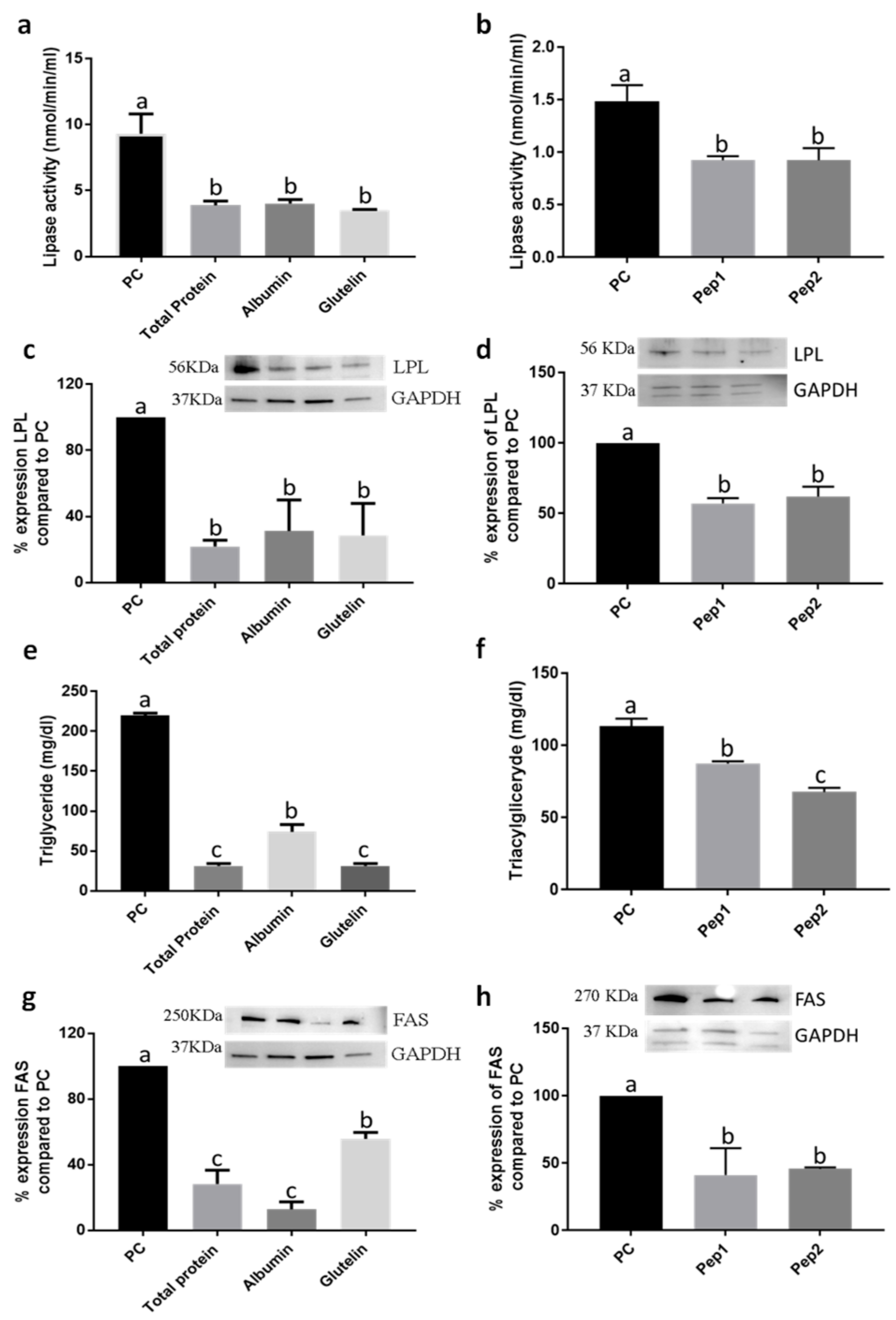
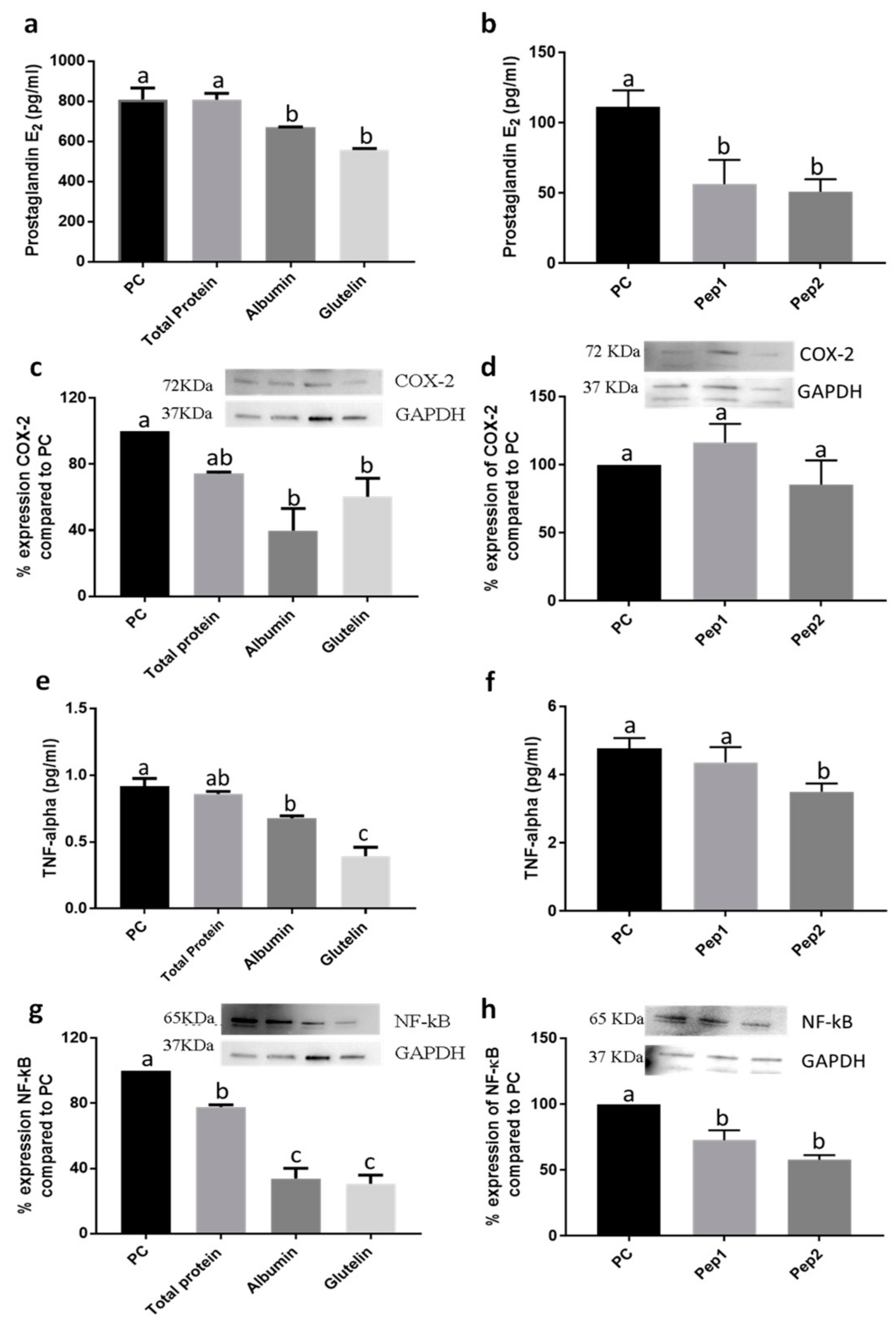

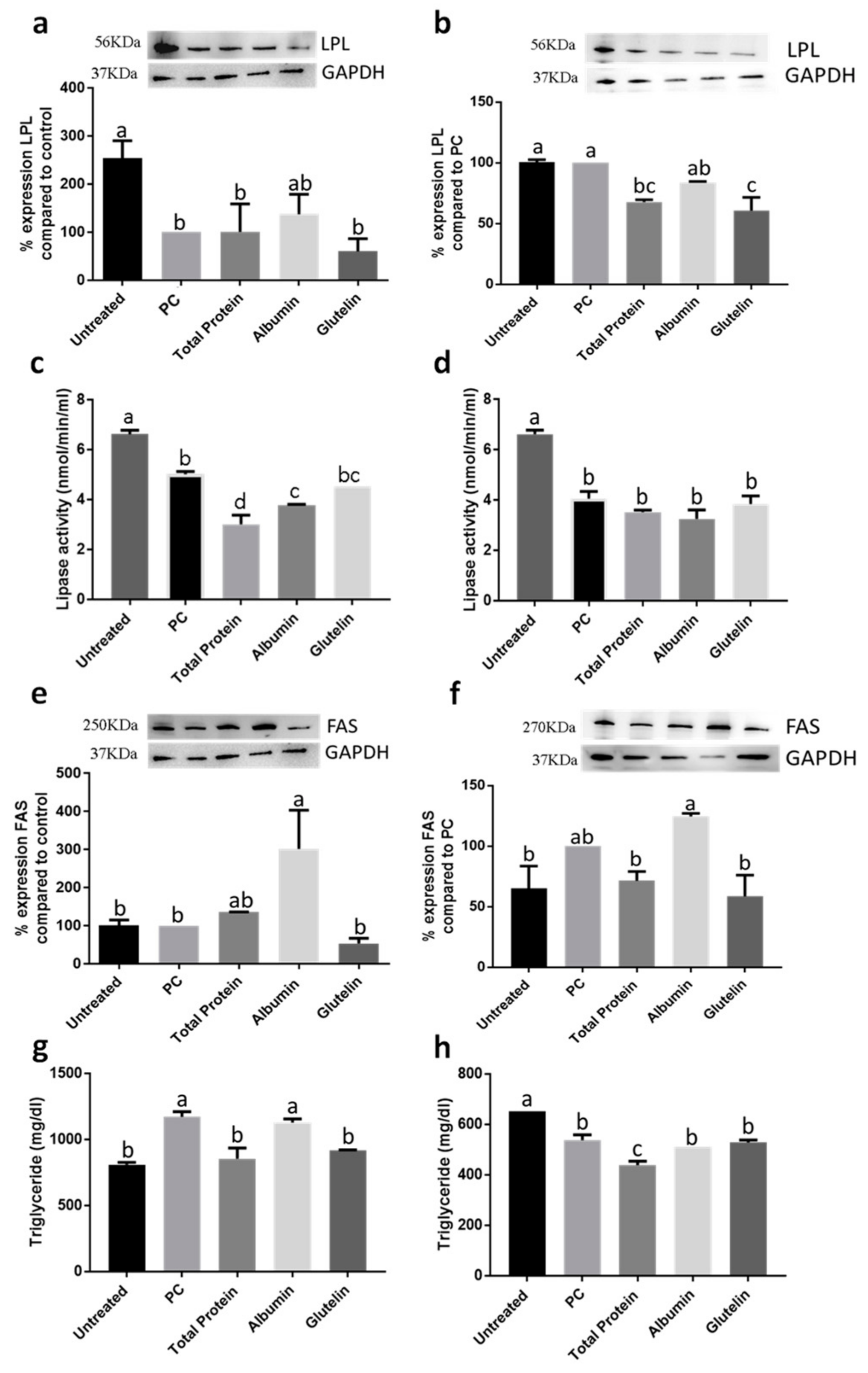
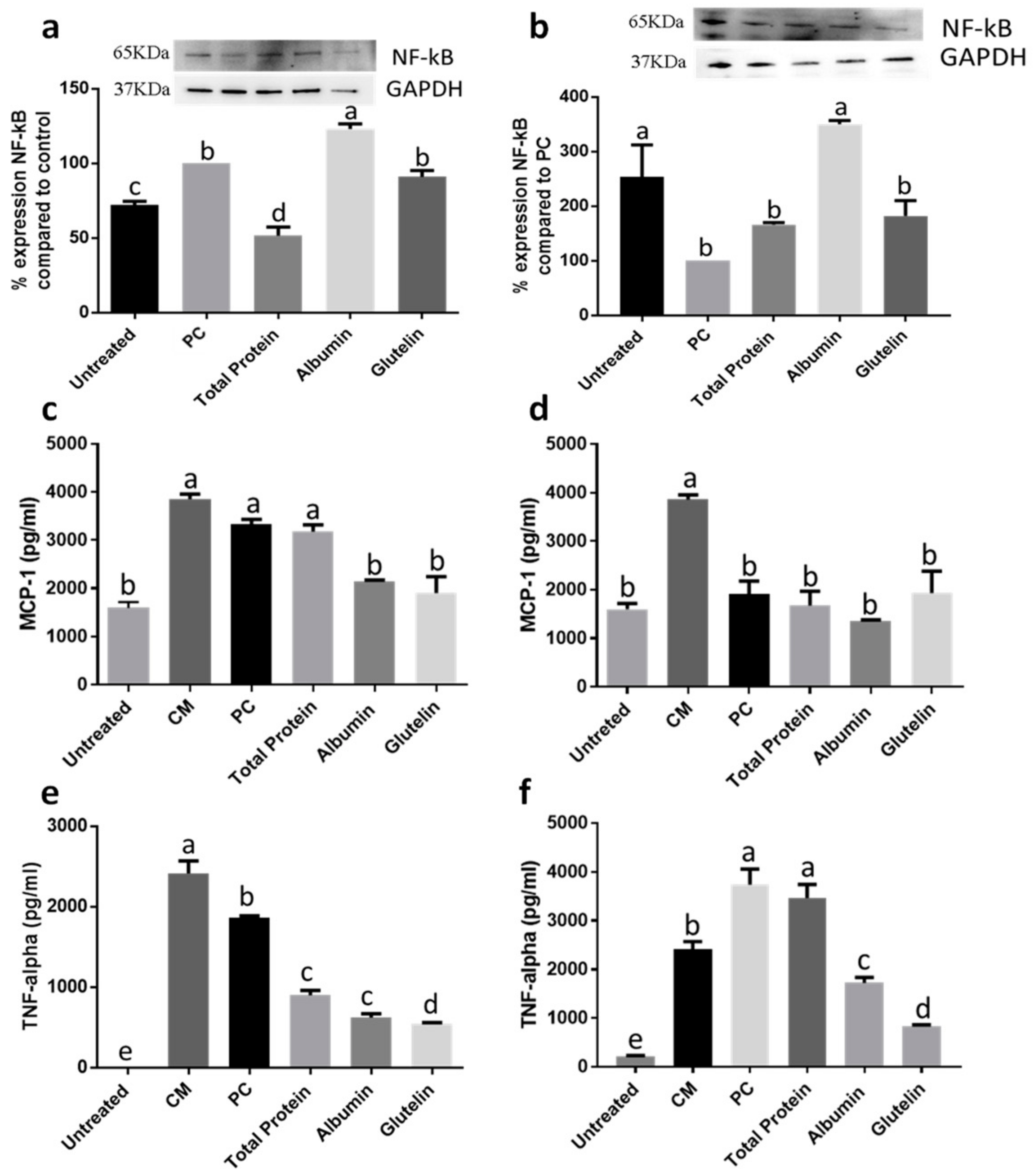
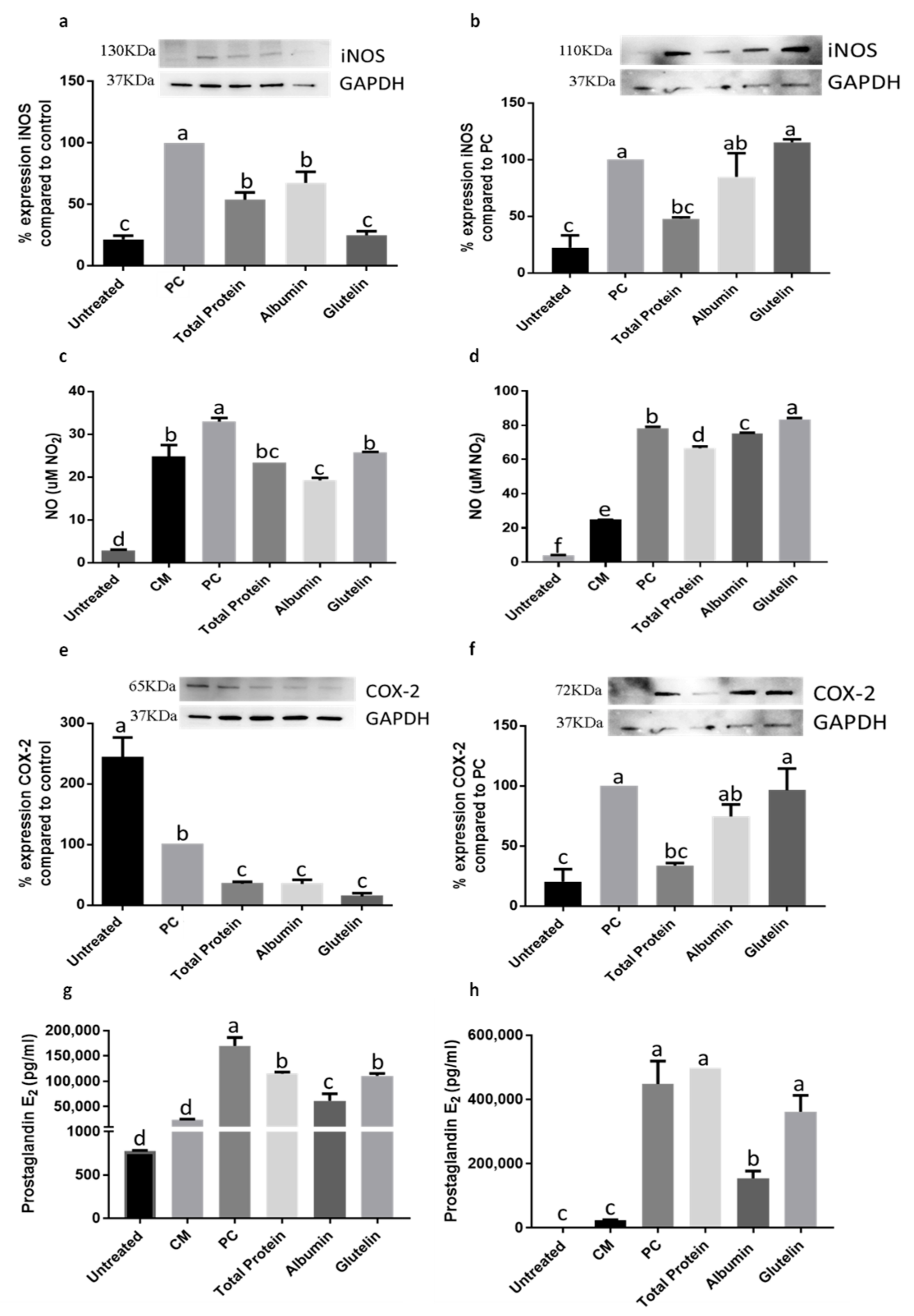
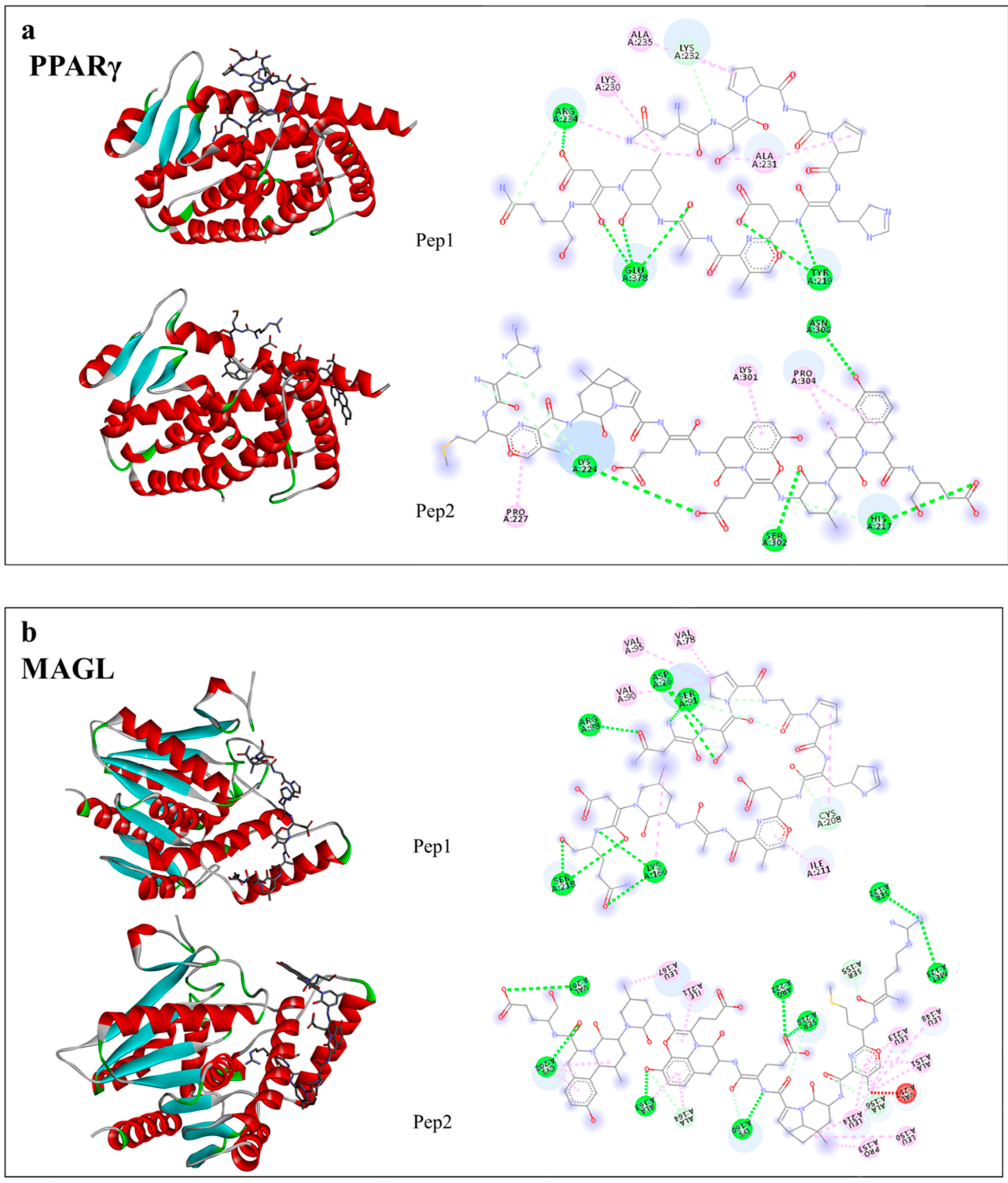
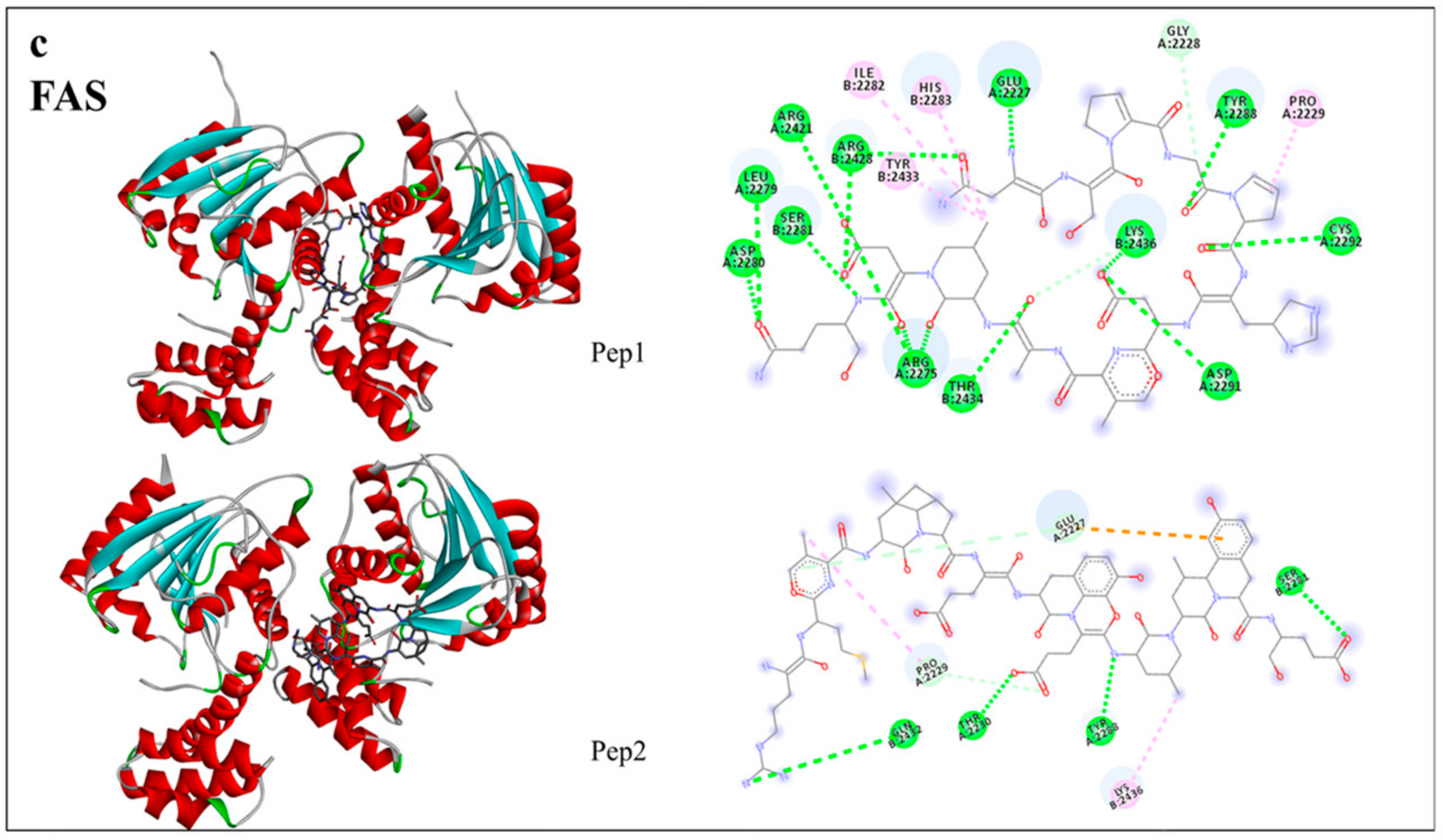

Publisher’s Note: MDPI stays neutral with regard to jurisdictional claims in published maps and institutional affiliations. |
© 2021 by the authors. Licensee MDPI, Basel, Switzerland. This article is an open access article distributed under the terms and conditions of the Creative Commons Attribution (CC BY) license (http://creativecommons.org/licenses/by/4.0/).
Share and Cite
Grancieri, M.; Martino, H.S.D.; Gonzalez de Mejia, E. Protein Digests and Pure Peptides from Chia Seed Prevented Adipogenesis and Inflammation by Inhibiting PPARγ and NF-κB Pathways in 3T3L-1 Adipocytes. Nutrients 2021, 13, 176. https://doi.org/10.3390/nu13010176
Grancieri M, Martino HSD, Gonzalez de Mejia E. Protein Digests and Pure Peptides from Chia Seed Prevented Adipogenesis and Inflammation by Inhibiting PPARγ and NF-κB Pathways in 3T3L-1 Adipocytes. Nutrients. 2021; 13(1):176. https://doi.org/10.3390/nu13010176
Chicago/Turabian StyleGrancieri, Mariana, Hércia Stampini Duarte Martino, and Elvira Gonzalez de Mejia. 2021. "Protein Digests and Pure Peptides from Chia Seed Prevented Adipogenesis and Inflammation by Inhibiting PPARγ and NF-κB Pathways in 3T3L-1 Adipocytes" Nutrients 13, no. 1: 176. https://doi.org/10.3390/nu13010176
APA StyleGrancieri, M., Martino, H. S. D., & Gonzalez de Mejia, E. (2021). Protein Digests and Pure Peptides from Chia Seed Prevented Adipogenesis and Inflammation by Inhibiting PPARγ and NF-κB Pathways in 3T3L-1 Adipocytes. Nutrients, 13(1), 176. https://doi.org/10.3390/nu13010176





